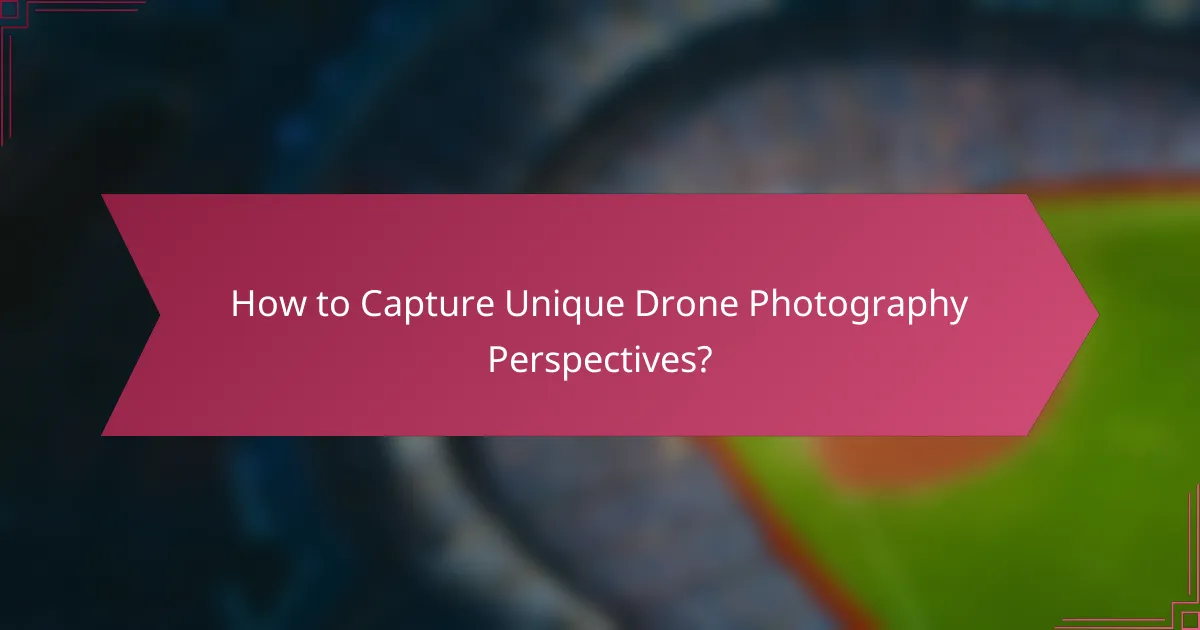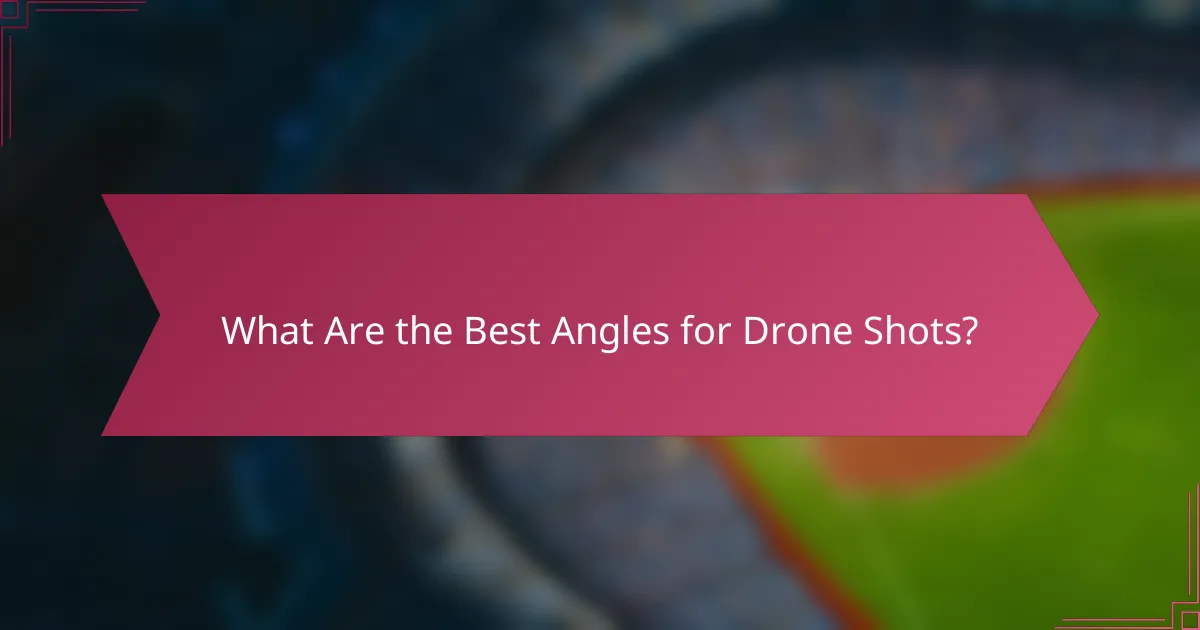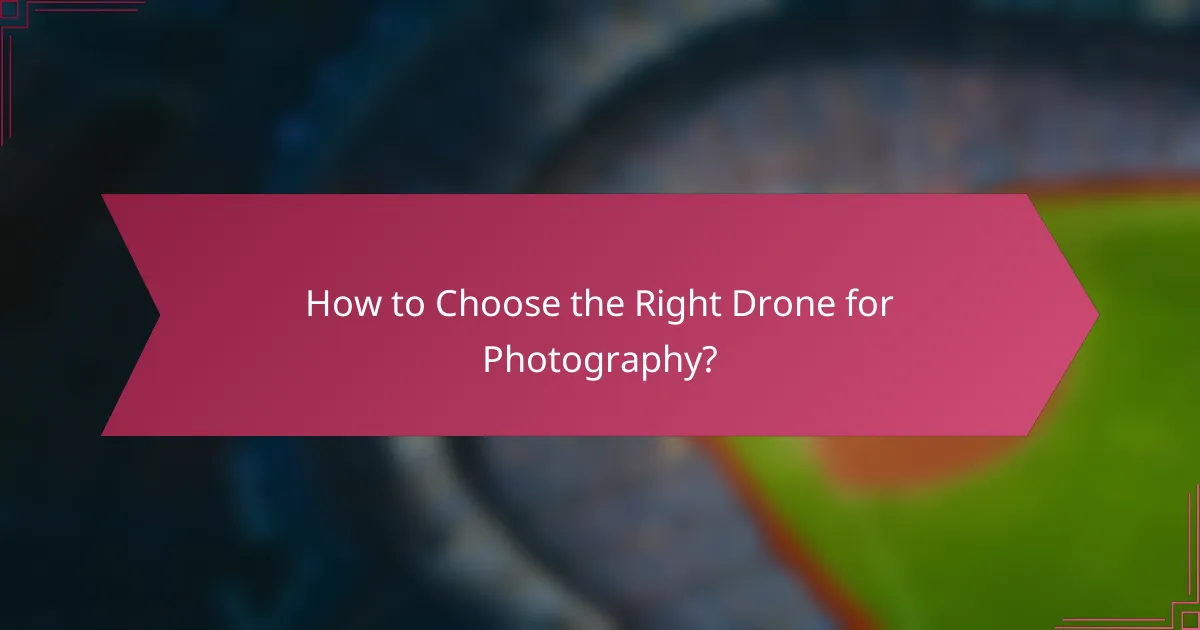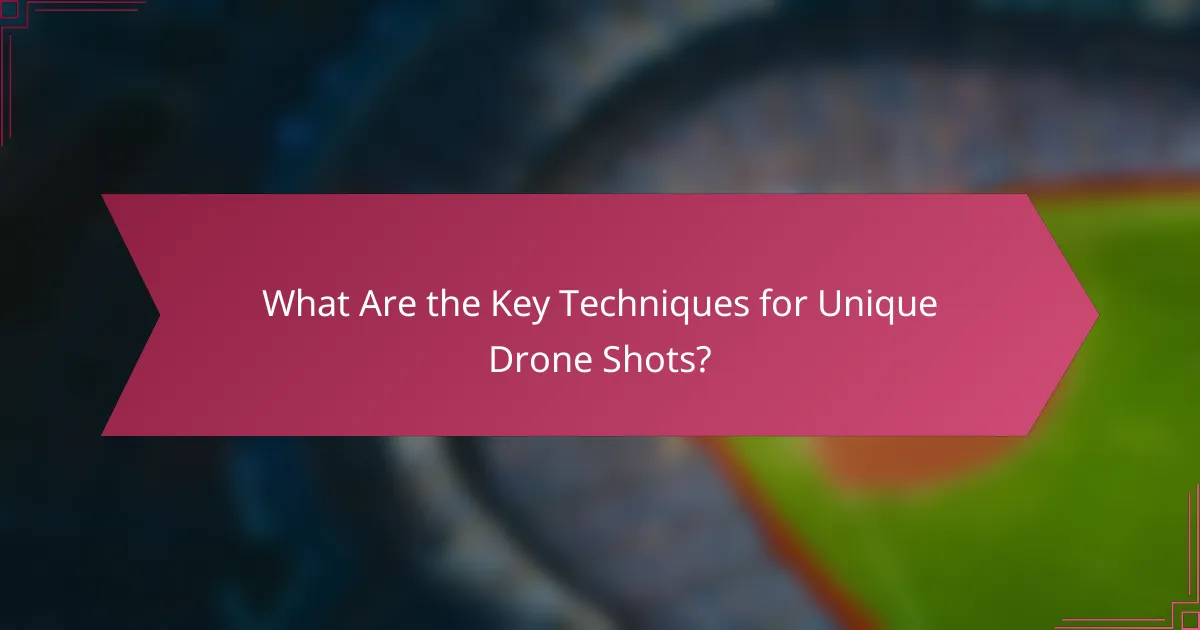Drone photography offers a unique opportunity to capture stunning perspectives and angles that traditional photography cannot achieve. By experimenting with innovative compositions and various viewpoints, photographers can create striking images that enhance storytelling and visual impact. Selecting the right drone is crucial, as it influences image quality and usability, making it essential to consider camera specifications and flight capabilities to meet your creative needs.

How to Capture Unique Drone Photography Perspectives?
To capture unique drone photography perspectives, focus on innovative angles and compositions that highlight the subject from above. Experimenting with various techniques can lead to striking images that stand out in any portfolio.
Utilize aerial vantage points
Aerial vantage points are essential for showcasing landscapes and subjects from a fresh perspective. Position your drone at different heights and distances to reveal patterns and details that are not visible from the ground. For instance, shooting from 50 to 150 meters can provide a broad overview while maintaining clarity.
Consider the surroundings and how they interact with your subject. A high vantage point can emphasize scale, making small features appear more significant against vast backgrounds.
Incorporate foreground elements
Including foreground elements in your drone shots can add depth and context to your images. Look for interesting textures or shapes, such as trees, rocks, or water bodies, to frame your subject. This technique draws the viewer’s eye into the scene, creating a more immersive experience.
When composing your shot, ensure that the foreground does not overpower the main subject. Balance is key; a well-placed element can enhance the overall composition without distracting from the focal point.
Experiment with altitude variations
Varying your altitude can dramatically change the perspective of your drone photography. Lower altitudes can capture intricate details, while higher altitudes offer a broader view of the landscape. Try shooting at different heights, such as 10 to 30 meters for close-ups or 100 to 200 meters for expansive shots.
Be mindful of local regulations regarding drone flight altitudes, as some areas may have restrictions that limit how high you can fly.
Use natural framing techniques
Natural framing techniques involve using elements in the environment to create a frame around your subject. Look for features like arching trees, cliffs, or buildings that can serve as a border. This approach not only highlights your subject but also adds a layer of interest to the composition.
When framing, ensure that the natural elements enhance rather than obstruct your subject. A well-framed shot can lead to a more compelling image that captures attention.
Adjust camera angles for dynamic shots
Adjusting camera angles can significantly impact the dynamism of your drone photography. Tilt the camera slightly or rotate it to capture unique perspectives that convey movement or drama. For example, a low-angle shot looking up at a subject can create a sense of grandeur.
Experiment with different angles during flight to find the most engaging compositions. Avoid static shots; dynamic angles can transform an ordinary scene into an extraordinary visual story.

What Are the Best Angles for Drone Shots?
The best angles for drone shots depend on the subject and the desired effect. Utilizing various perspectives can enhance the visual impact and storytelling of your images.
Top-down angle for landscapes
The top-down angle, also known as a bird’s-eye view, is ideal for capturing expansive landscapes. This perspective allows for a comprehensive view of the terrain, showcasing patterns, textures, and colors that might be missed from ground level.
When using this angle, consider flying at a height that balances detail with context. Heights between 50 to 150 meters are often effective for landscapes, depending on the area’s topography and features.
Low-angle shots for dramatic effects
Low-angle shots create a sense of grandeur and drama, making subjects appear larger than life. This angle is particularly effective for architecture or natural features like mountains, emphasizing their scale against the sky.
To achieve this effect, fly the drone close to the subject while maintaining a low altitude. Angles between 10 to 30 degrees from the ground can produce striking results, but be cautious of obstacles and regulations regarding altitude.
Side angles for depth perception
Side angles help convey depth and dimension in your photos. By positioning the drone to the side of your subject, you can create a three-dimensional effect that enhances the viewer’s sense of space.
When capturing side angles, consider the lighting and shadows, as they can add to the depth perception. Shooting during the golden hour can provide softer light and longer shadows, enhancing the three-dimensional feel of the image.
Oblique angles for unique perspectives
Oblique angles offer a creative twist, allowing for dynamic compositions that can highlight both the subject and its surroundings. This angle combines elements of both top-down and side views, providing a fresh perspective.
To achieve oblique angles, tilt the drone slightly while capturing the shot. This technique can be particularly effective in urban environments or when photographing intricate landscapes, as it draws attention to patterns and relationships within the scene.

How to Choose the Right Drone for Photography?
Choosing the right drone for photography involves considering several key factors that impact image quality and usability. Focus on camera specifications, flight capabilities, and user-friendly features to find a drone that meets your photography needs.
Consider camera quality and resolution
The camera quality is crucial for capturing stunning aerial images. Look for drones with at least 12 MP resolution for decent photos, while 20 MP or higher is preferable for professional-grade shots.
Additionally, consider features like 4K video capability and adjustable aperture settings. These enhancements can significantly improve the final output, allowing for more creative control over your shots.
Evaluate flight time and battery life
Flight time directly affects how much you can shoot in one session. Most consumer drones offer flight times ranging from 20 to 30 minutes, but higher-end models may provide up to 40 minutes.
Battery life is also important; consider investing in extra batteries to extend your shooting sessions. Always check the drone’s charging time, as some models may take several hours to recharge fully.
Assess ease of use and controls
User-friendly controls can make a significant difference, especially for beginners. Look for drones with intuitive interfaces and responsive controls that allow you to focus on capturing images rather than struggling with the technology.
Features like GPS stabilization and automated flight modes can enhance ease of use. These options help ensure steady shots and simplify complex maneuvers, making it easier to achieve professional results.
Look for obstacle avoidance features
Obstacle avoidance technology is essential for safe flying, especially in complex environments. Drones equipped with sensors can detect and avoid obstacles, reducing the risk of crashes and damage.
Consider models with multi-directional sensors for comprehensive coverage. This feature allows for safer navigation and can help you focus on photography without worrying about potential hazards in your flight path.

What Are the Key Techniques for Unique Drone Shots?
Key techniques for capturing unique drone shots include mastering composition principles, utilizing motion effects, and incorporating symmetry. These methods enhance visual storytelling and can significantly improve the overall impact of aerial photography.
Mastering the rule of thirds
The rule of thirds is a fundamental composition technique that divides an image into nine equal parts using two horizontal and two vertical lines. Positioning key elements along these lines or at their intersections creates a more balanced and engaging photograph. For drone photography, consider placing the horizon along the top or bottom third of the frame to draw attention to either the sky or the landscape.
When applying this rule, avoid centering your subject unless it serves a specific purpose. Experiment with different placements to see how they affect the overall feel of your shot. This technique works well in various environments, from urban landscapes to natural vistas.
Using motion blur for effect
Motion blur can add a dynamic quality to drone photography, conveying movement and energy. To achieve this effect, use slower shutter speeds while the drone is in motion, allowing the background to blur while keeping the subject sharp. This technique is particularly effective in capturing moving subjects like vehicles or people.
Be mindful of the wind conditions, as they can affect the stability of your drone and the quality of the blur. A shutter speed of around 1/30 to 1/60 seconds can often yield pleasing results, but adjust based on your specific situation. Always ensure that your drone is stable enough to avoid excessive blur that could detract from the image.
Incorporating symmetry in compositions
Symmetry creates a sense of harmony and balance in photographs, making them visually appealing. In drone photography, look for natural or architectural elements that exhibit symmetry, such as roads, rivers, or buildings. Position your drone directly above or at an angle that accentuates this symmetry for striking compositions.
While symmetrical shots can be captivating, consider breaking the symmetry occasionally to create tension or interest. This can be achieved by including an asymmetrical element in the frame or by using leading lines that draw the viewer’s eye. Experiment with both approaches to find the right balance for your unique shots.
